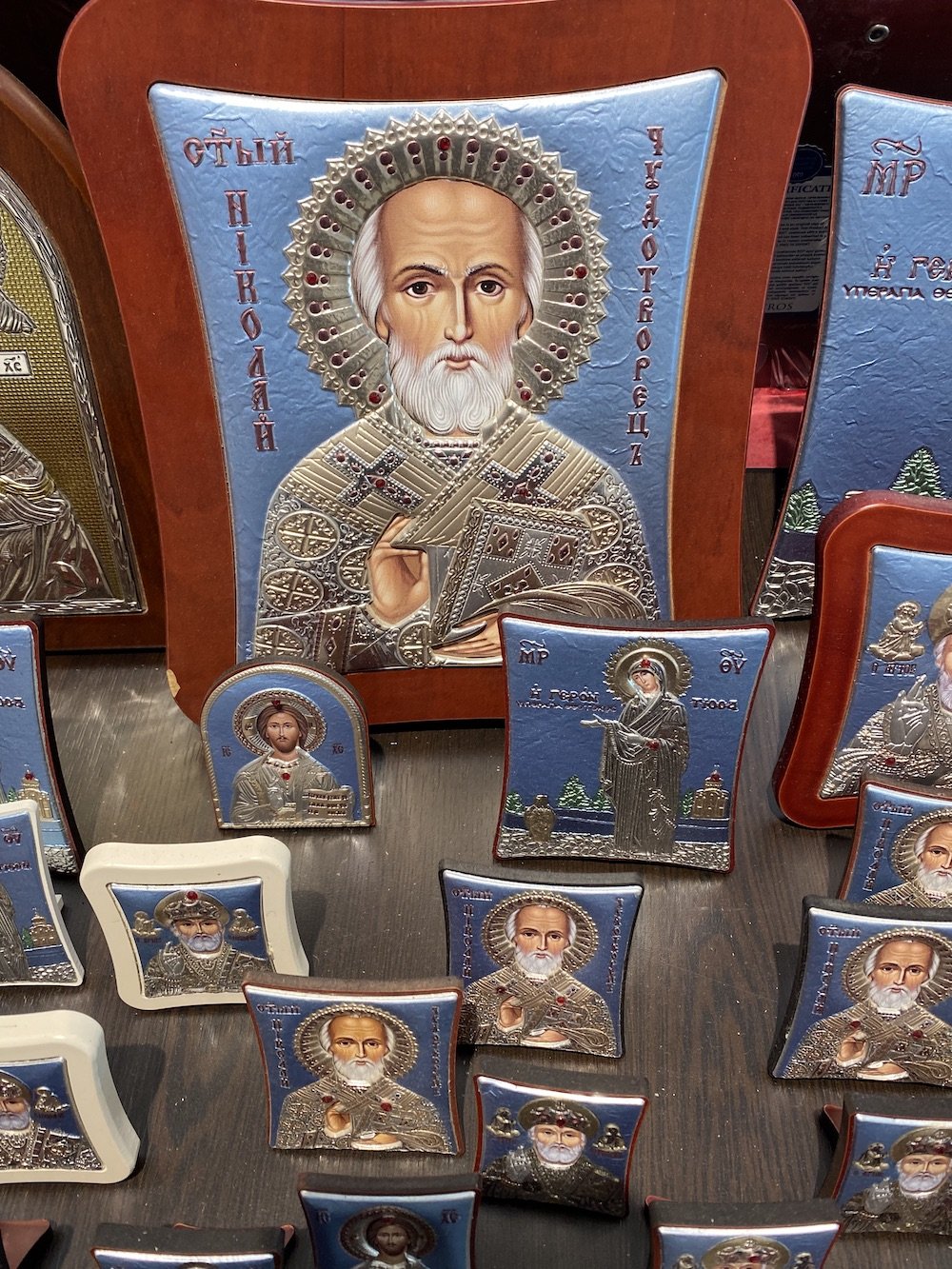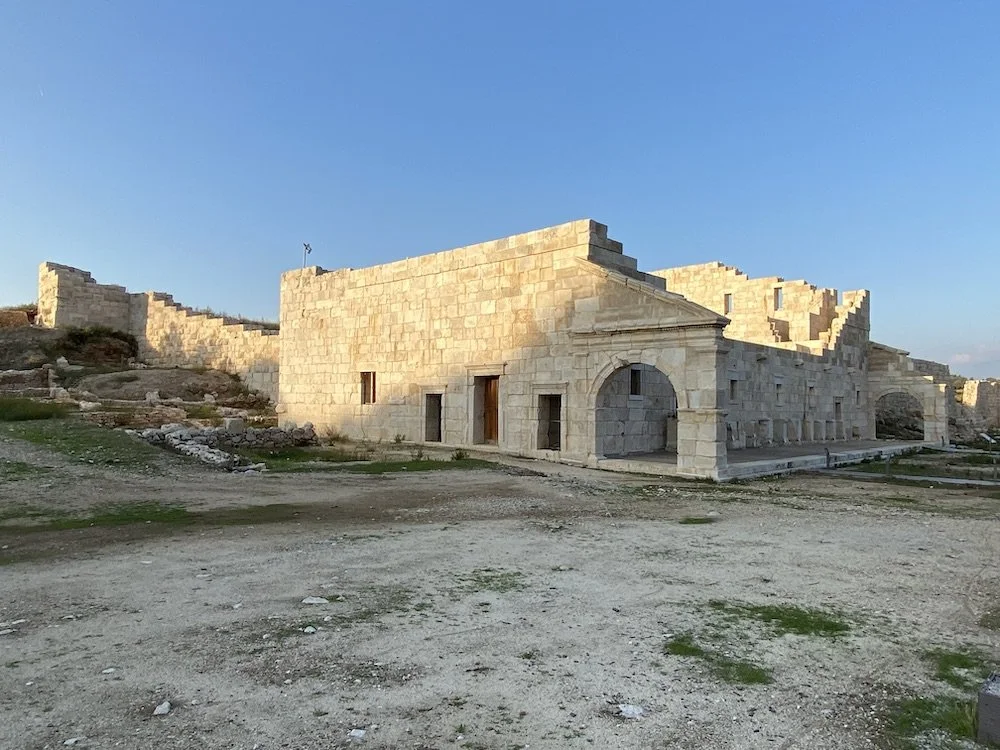In Search Of The Real St. Nicholas’ Deep Roots In Turkey
St. Nicholas icons for sale at a Demre gift shop. Photo by Kim Lawton.
DEMRE, Turkey — ’Tis the season when Santa Claus is nearly everywhere. Most people know that jolly old St. Nick hails from the North Pole. But many might not realize that the real St. Nicholas, a fourth century Christian bishop, lived and worked in what is now the country of Turkey.
“Most visitors have no idea how much of early Christian history happened in Turkey,” said veteran tour guide and Turkey specialist Servet Ugur.
The modern pop culture Santa evolved from stories about Bishop Nicholas of Myra, who was revered for centuries because of his selfless generosity, good deeds and love of others, especially children.
Nicholas was born sometime after the year 260 in the important harbor city of Patara, in the Greek-speaking Roman province of Lycia, Asia Minor. The ancient city is in modern-day southwestern Turkey, along the Mediterranean coast. According to the New Testament Book of Acts, the Apostle Paul and the Gospel writer Luke changed ships in Patara. The ancient city was known for its worship of the Greek god Apollo.
During the time of Nicholas, Asia Minor was going through a period of great transition, says Adam English, professor of theology and philosophy at Campbell University in North Carolina and author of “The Saint Who Would Be Santa Claus: The True Life and Trials of St. Nicholas of Myra.”
When Nicholas was born in the late 200s, “Christianity was still an illegal religion, and there were lots of abrupt periods of persecution and violence ordered by (Roman) Emperor Diocletian,” says English. Emperor Constantine I came to power in 306. He decriminalized Christianity and eventually made it “the preferred religion,” English added.
Little is known for certain about Nicholas, although many stories about him have been passed down for centuries. According to tradition, he was born to a wealthy Christian family in Patara, and his uncle was a priest. After Nicholas’ parents died when he was young, he is said to have given away his inherited wealth to needy people before entering the priesthood.
The excavated and reconstructed government building and assembly hall in the ancient city of Patara, in what is now Turkey. Patara was the hometown of St. Nicholas. Photo by Kim Lawton.
One of the earliest and most famous stories about Nicholas involves a poor family in Patara who could not afford marriage dowries for their three daughters. The girls faced being sold into slavery or prostitution. During nighttime, Nicholas secretly delivered three bags of gold to the family. Some legends say he tossed the bags of gold through an open window or down the chimney, where they landed in stockings or shoes that were drying by the fire. Many believe this was the inspiration for the tradition of the Christmas stocking.
English asserts that this Nicholas story is unique from other early Christian “hero” stories. “Most of the stories featured people who were martyrs, people who died for the faith or maybe who did something miraculous,” he said. “In this event, Nicholas is doing something out of the goodness of his heart. It’s something quite ordinary. He doesn’t want to be recognized for his good works.”
Today, visitors can get a small sense of what Nicholas’ hometown was like. Although most of Patara remains in ruins, a portion has been excavated and reconstructed, including a column-lined street, a massive government building and assembly hall, and a Roman theater that seated about 6,000 people. The harbor has since silted up, but the Mediterranean beach is just a short walk from the excavated areas.
Nicholas was eventually appointed bishop of nearby Myra, another Greek-speaking port city in the Lycia province. According to the Book of Acts, the Apostle Paul and his companions came to Myra and from there boarded a ship headed to Italy.
There are many stories about Nicholas’ ministry in Myra, although little historical documentation exists. He is included in lists of the more than 300 bishops from across the Christian world who gathered in the year 325 at the Council of Nicaea, which took place in what is now the Turkish city of Iznik. Emperor Constantine convened the church council to hammer out foundational beliefs of Christianity, especially regarding the nature of the Trinity. The resulting doctrinal statement, the Nicene Creed, is still recited in churches today. According to tradition, during the meeting, when church leader Arius from Egypt argued that Jesus was not equal to God the Father, Nicholas slapped him.
Nicholas died on Dec. 6 sometime after the year 333. “We’re less certain about the year than the day,” said English, who notes that Christians celebrated Nicholas on Dec. 6 for centuries.
“He died of old age,” English added. “We have no indication that there was any sort of martyrdom or foul play.” Nicholas’ burial site became an early place of pilgrimage.
Exteriors of the St. Nicholas Church in the ancient city of Myra, now Demre, Turkey. Turkey recognizes this as the St. Nicholas Memorial Museum. Photo by Kim Lawton.
Several areas of ancient Myra have been excavated, including the church in what is now the town of Demre, Turkey. The current structure was built in the sixth century over a fourth century site where Nicholas likely worked and was later buried. During the Middle Ages, the church was flooded and then buried under several feet of silt. In the 1860s, Russian Czar Nicholas I funded a project to excavate and renovate the church.
Excavations and new discoveries continue, with significant portions of the church still closed to tourists because of the ongoing work. Earlier this year, Turkish archeologists announced they had uncovered mosaic floors dating back to the time of Nicholas.
Excavations continue inside the St. Nicholas Church in the ancient city of Myra, now Demre. Archeologists recently uncovered mosaic floors dating back to the 4th Century under the 6th Century floors. Photo by Kim Lawton.
“We are talking about the floor on which St. Nicholas’ feet stepped,” local official Osman Eravsar told the Turkish news agency DHA.
Archeologists also announced they had discovered the actual spot of Nicholas’ tomb inside the church, although that remains under dispute among historians. Some local officials suggested that some of Nicholas’ bones could still be at the church, but that has been a matter of controversy for centuries. According to firsthand accounts, in 1087, Italian merchant sailors entered the church and took the bones, carrying them to Bari, Italy, ostensibly to rescue the relics from Seljuk Turk invaders. The Basilica di San Nicola in Bari, which now houses those relics, is an important Christian pilgrimage destination.
About a decade later, Christian crusaders came to the church and collected more bones, perhaps those left behind by the Bari sailors, and brought them to Venice. Small bone fragments purported to be relics of Nicholas can be found in churches around the world. The Antalya Archeological Museum in Antalya, about 90 miles north of Demre, has what it claims are several Nicholas relics in a glass-protected display.
Visitors to the St. Nicholas Church are currently able to see several layers of mosaic floors that show the different eras of the building. Beautiful fresco fragments decorate the walls. In a tiny side room, pilgrims can view a sarcophagus behind a glass panel. Tour guides claim it once held the remains of the saint.
An icon of St. Nicholas and a reliquary with bones said to be from St. Nicholas at the Antalya Archeological Museum in Antalya, Turkey on the southwestern Mediterranean coast. Photo by Kim Lawton.
Today, Turkey recognizes the site as the St. Nicholas Memorial Museum and not as a functioning place of worship. Religious services are forbidden there, except on Dec. 6, the Feast Day of St. Nicholas. Several times in the past, even those services were not allowed. This year, a Divine Liturgy service took place, led by a metropolitan from the Greek Orthodox Patriarchate in Istanbul. A couple hundred people, mostly Russian tourists, attended. After the service, a priest allowed pilgrims to venerate Nicholas’ relics in a small box or reliquary. In recent years, officials have allowed a few other services on holy days as well.
Turkey, which is an officially secular nation, is about 99% Muslim. Both Christians and Muslims struggle with the conflagration of the fourth century bishop and the Western pop culture Santa Claus. A large red-suited, blue-eyed Santa statue once stood in front of the Demre church. The statue generated controversy among local Turks and devout pilgrims alike. In 2008, it was moved to the front of a gift shop outside the church gates, where it still stands. Inside the shop, visitors can purchase Nicholas icons and Santa kitsch.
A Santa Claus statue in front of a gift shop across the street from the St. Nicholas Church in the ancient city of Myra, now Demre, Turkey. Photo by Kim Lawton.
The Feast Day of St. Nicholas has been celebrated widely across Europe for centuries, including in the Netherlands, where the saint is known as Sinterklaas, the apparent inspiration for Santa Claus. Thanks to a boost from 19th century American writers and 20th century advertisers, St. Nicholas’ cultural significance has soared in the United States as well.
On the Feast Day of St. Nicholas, Dec. 6, 2022, Orthodox priests were allowed to show relics of St. Nicholas for pilgrims to venerate. Photo by Kim Lawton.
Yet, many acknowledge that Nicholas’ enduring popularity is something of a mystery. “He wasn't a martyr, and he didn't write a book or even say something memorable,” said Frederica Matthewes-Green, author of several books ,including “Facing East: A Pilgrim’s Journey into the Mysteries of Orthodoxy.”
Matthewes-Green said for her, and for many other Christians, the answer is spiritual: “Something about St. Nicholas persisted through the ages, drawing people and causing them to admire and trust him, and to ask him to pray for them. Those prayers, to this day, are still answered,” she said.
English believes the stories of Nicholas’ unselfish generosity have resonated across the centuries.
“It’s still the kind of story that people appreciate, that people can relate to, and they feel inspired by,” he says. “The messages of kindness and generosity are still ones … that we need.”
Kim Lawton is president of Kim Lawton Media, a video production and media consulting company near Washington, D.C. She is the former managing editor of the highly-acclaimed PBS series "Religion & Ethics NewsWeekly." She traveled to Turkey in early December on a trip sponsored by the Turkiye Tourism Promotion and Development Agency.







